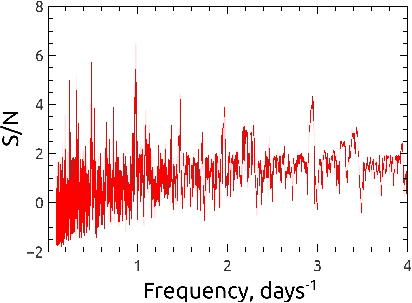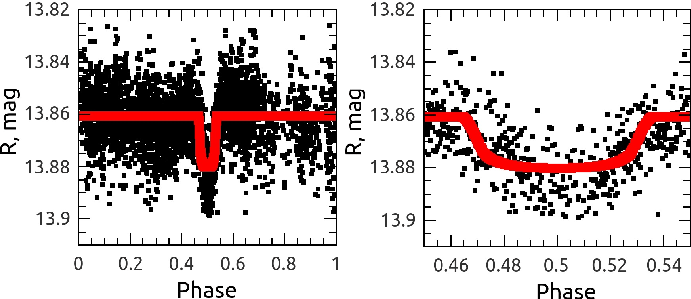| Астронет | Картинка дня | Обзоры astro-ph | Новости | Статьи | Книги | Карта неба | Созвездия | Переменные Звезды | A&ATr | Глоссарий |
| планета Астронет | Физика космоса | Биографии | Словарь | Ключевые слова | Астрономия в России | Форумы | Семинары | Сверхновые |
|
Peremennye Zvezdy (Variable Stars) 33, No. 2, 2013 Received 13 February; accepted 22 February.
|
Article in PDF |
Two Transiting Exoplanet Candidates in Cygnus from the MASTER Project
A. Y. Burdanov1, A. A. Popov1, V. V. Krushinsky1, K. I. Ivanov2
- Kourovka Astronomical Observatory of Ural Federal
University, Mira Str. 19, 620002 Ekaterinburg, Russia; e-mail:
burdanov.art@gmail.com
- Irkutsk State University, Karl Marx Str. 1, 664003 Irkutsk, Russia
|
We present two transiting exoplanet candidates in
Cygnus discovered during a small photometric survey performed at
the Kourovka Astronomical Observatory of Ural Federal University
in the summer of 2012. The MASTER-1 b candidate (host star 2MASS
20260213+5006032,
|
1. INTRODUCTION
The main goal of the MASTER project is performing a synoptic sky survey in order to find various optical transients, i.e. for GRB prompt observations, SN and Novae discoveries, minor-planet and comet observations and discoveries (Lipunov et al. 2010). In most cases, these objectives do not require high-precision photometry but project capabilities allow such kind of observations. Having developed a technique for high-precision photometry with the MASTER-II telescope series, we used the MASTER-II-Ural telescope for research of open clusters and observations of transits of known exoplanets. During short and bright summer nights of 2012, we performed a pilot photometric survey aimed at finding transiting exoplanets and unknown variable stars at the Kourovka Astronomical Observatory of Ural Federal University.
2. OBSERVATIONS
Observations were carried out between May and August, 2012 with the Master-II-Ural telescope. An additional set of observations was acquired in December, 2012. During 50 nights, we obtained 3600 frames in a
The instrument consists of a pair of 40 cm Hamilton catadioptric
telescopes with the focal length of 100 cm, installed on the same
equatorial mount and equipped with two Peltier-cooled Apogee Alta
U16M CCD cameras. The image scale is 1.85
![]() /px. The
observations can be performed simultaneously in two filters (the
Johnson-Cousins
/px. The
observations can be performed simultaneously in two filters (the
Johnson-Cousins ![]() system) or in two different polarization
planes.
system) or in two different polarization
planes.
At the time of our summer observations, we obtained frames only in
the ![]() filter, with 50
filter, with 50![]() exposure times, because only one of
the CCD cameras worked properly. However, additional observations
in December, 2012 were made in the
exposure times, because only one of
the CCD cameras worked properly. However, additional observations
in December, 2012 were made in the ![]() and
and ![]() filters. For
photometric calibration, we used dark-current frames obtained
before each observational night and flat-field frames obtained on
the morning twilight sky after every observational night. All
observations were carried out in automatic mode.
filters. For
photometric calibration, we used dark-current frames obtained
before each observational night and flat-field frames obtained on
the morning twilight sky after every observational night. All
observations were carried out in automatic mode.
3. DATA REDUCTION
Initial astrometric reductions were performed using console version of the Astrometry.net application (Lang et al. 2010). Photometric reductions were made using IRAF (Tody 1993) and consisted of master dark frame substraction from raw frames and division by the master flat field frame. Then, using IRAF scripts, we estimated the average FWHM and sky background for each frame. The IRAF/apphot task was used to perform aperture photometry with individual values of FWHM and sky background for each frame. To get the initial instrumental magnitudes and to correct them, we used a console application Astrokit written by two of us (V. Krushinsky and A. Burdanov) on the basis of modified algorithm of Everett & Howell (2001). This application allows us to introduce corrections for brightness variations associated with variability of atmospheric transparency using individual ensemble of reference stars for every star in the field, to search for variable stars using the RoMS criteria of Rose & Hintz (2007). Astrokit also permits to process large numbers of objects simultaneously, in an automatic mode.
Photometric data were obtained for 21500 stars with accuracy from
0![]() 006 to 0
006 to 0![]() 06 for stars from 10
06 for stars from 10![]() 0 to 16
0 to 16![]() 0,
respectively. To convert the instrumental magnitudes to the
standard system, we used Johnson
0,
respectively. To convert the instrumental magnitudes to the
standard system, we used Johnson ![]() and SDSS
and SDSS ![]() magnitudes from
the UCAC4 catalogue (Zacharias et al. 2012) and equations from
Jordi et al. (2006) to derive Johnson
magnitudes from
the UCAC4 catalogue (Zacharias et al. 2012) and equations from
Jordi et al. (2006) to derive Johnson ![]() magnitudes.
magnitudes.
To search for transit-like signals, we selected about 5000 stars
with the standard deviation of magnitudes for the entire series of
observations less than 0![]() 02, i.e. for which it is possible to
detect a transit of a Hot Jupiter with a depth of about 0
02, i.e. for which it is possible to
detect a transit of a Hot Jupiter with a depth of about 0![]() 01.
Searching for periods was performed with the BLS method
(Box-fitting Least Squares, Kovács et al. 2002) using the
VARTOOLS package (Hartman et al. 2008). Periods with a high S/N
ratio on the periodogram were used for plotting phase curves.
Transit fitting was also performed in the VARTOOLS package. As a
preliminary result, we discovered two stars with strong
transit-like signals.
01.
Searching for periods was performed with the BLS method
(Box-fitting Least Squares, Kovács et al. 2002) using the
VARTOOLS package (Hartman et al. 2008). Periods with a high S/N
ratio on the periodogram were used for plotting phase curves.
Transit fitting was also performed in the VARTOOLS package. As a
preliminary result, we discovered two stars with strong
transit-like signals.
4. EXOPLANET CANDIDATES
MASTER-1 b CANDIDATE
Transits of the MASTER-1 b candidate were observed 4 times, and 3 of them were full transits. The BLS spectrum is shown in Fig. 1. The peak corresponding to the period of 0
According to the 2MASS catalogue (Skrutskie et al. 2006),
magnitudes of the host star 2MASS 20260213+5006032 are
![]() ,
,
![]() , and
, and
![]() . From our
observations in two filters made in December, 2012,
. From our
observations in two filters made in December, 2012,
![]() and
and
![]() . Following Pickles (1998), the color indices
were used to estimate the approximate spectral type of the star
without accounting for interstellar redening. The formal spectral
type of the host star is G0-M8. The proper motion of the star is
. Following Pickles (1998), the color indices
were used to estimate the approximate spectral type of the star
without accounting for interstellar redening. The formal spectral
type of the host star is G0-M8. The proper motion of the star is
![]() mas/yr,
mas/yr,
![]() mas/yr (Roeser et
al. 2010). The upper limit to the distance is 2300 pc from the
proper motion, as it follows from the equation:
mas/yr (Roeser et
al. 2010). The upper limit to the distance is 2300 pc from the
proper motion, as it follows from the equation:
| (1) |
Transit fitting using the Mandel-Agol transit model (Mandel &
Agol 2002) was performed with the VARTOOLS package. Initial
parameter values were determined based on the results from the BLS
search method. For fitting, we used a quadratic limb-darkening
law, varied the ephemeris (![]() and
and ![]() ), ratio of planet
radius to host star radius (
), ratio of planet
radius to host star radius (![]() ), ratio of semi-major axis
to host star radius (
), ratio of semi-major axis
to host star radius (![]() ), and inclination (
), and inclination (![]() ). Eccentricity
and argument of periastron were set to 0 and not varied. As the
result, we have:
). Eccentricity
and argument of periastron were set to 0 and not varied. As the
result, we have:
![]() ,
,
![]() ,
,
![]() ,
, ![]() ,
,
![]() .
.
MASTER-2 b CANDIDATE
Transits of the MASTER-2 b candidate were observed 4 times, and 2 of them were full transits. The BLS spectrum is shown in Fig. 3. The peak corresponding to the period of
The magnitudes of the host star 2MASS 20341625+5015427 are
![]() ,
,
![]() , and
, and
![]() . According to our
observations,
. According to our
observations,
![]() and
and
![]() . The formal
spectral type of the host star is G8-K5. We found no data on the
proper motion of the host star.
. The formal
spectral type of the host star is G8-K5. We found no data on the
proper motion of the host star.
Transit fitting was performed in the same way as for the first
candidate:
![]() ,
,
![]() ,
,
![]() ,
, ![]() ,
,
![]() .
.
5. CONCLUSION
Assuming that the host stars belong to the main sequence and have solar-like sizes, the candidates' radii and semi-major axes correspond to the Hot Jupiter type (like the known exoplanets WASP-18 b, WASP-19 b, and WASP-43 b). To verify the spectral types and luminosity classes of the host stars, follow-up spectroscopic observations are needed.
Acknowledgements: We would like to thank Ekaterina
Avvakumova and Anna Punanova (Kourovka Astronomical Observatory)
for their valuable remarks. This work was partly supported by the
Federal Task Program "Research and Operations on Priority
Directions of Development of the Science and Technology Complex of
Russia for 2007-2013" (contract 14.518.11.7064), by the Russian
Foundation for Basic Research grant 12-02-31095, and by a grant in
the form of a subsidy from Ministry of Education of the Russian
Federation (Agreement No. 8415 of August 27, 2012).
This research made use of Aladin (Bonnarel et al. 2000).
References:
Bonnarel F., Fernique P., Bienayme O. et al., 2000, Astron. & Astrophys. Suppl., 143, 33
Everett M.E., Howell S.B., 2001, Publ. Astron. Soc. Pacific, 113, 1428
Hartman J.D., Gaudi B.S., Holman M.J. et al. 2008, Astrophys. J., 675, 1254
Kovács G., Zucker S., Mazeh T., 2002, Astron. & Astrophys., 391, 369
Lang D., Hogg D.W., Mierle K. et al., 2010, Astron. J., 139, 1782
Lipunov V., Kornilov V., Gorbovskoy E. et al., 2010, Advances in Astronomy, 2010, article id. 349171
Mandel K., Agol E., 2002, Astrophys. J., 580, L171
Pickles A.J., 1998, Publ. Astron. Soc. Pacific, 110, 863
Rose M.B., Hintz E.G, 2007, Astron. J., 134, 2067
Roeser S., Demleitner M., Schilbach E., 2010, Astron. J., 139, 2440
Skrutskie M.F., Cutri R.M., Stiening R., et al., 2006, Astron. J., 131, 1163
Tody D., 1993, Astronomical Data Analysis Software and Systems II. ASP Conf. Ser. 52 (Ed. R.J. Hanisch, R.J.V. Brissenden, J. Barnes), p. 173
Zacharias N., Finch C.T., Girard T.M. et al., 2012, UCAC4 Catalog, Centre de Données Astronomiques de Strasbourg, I/322



